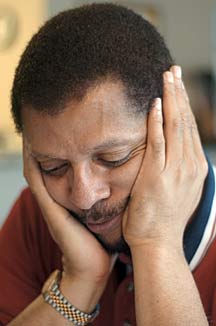
|

A incurable disease, narcolepsy
shows a host of odd symptoms
that are poorly understood
The strapping 6-foot-3 man appears at the peak of health at age 54, yet he suffers from a serious hidden disorder.
Robb Peterson assumed he was just tired when he kept falling asleep in high school and university classes.
He "thought nothing of it" when he fell asleep standing in formation at boot camp at Lackland Air Force Base after joining the service in 1971.
"I didn't fall down," he said. "One of the squad members said, 'What happened? You fell asleep.'"
He said he fell asleep while towing a buddy's car from Houston to Wichita Falls, Texas, in 1972 and would have been killed by a guardrail that plunged through the window if he hadn't slumped over. "I just figured I was tired driving through the night," he said.
In 1974 he was sent to Hickam Air Force Base and assigned to the First Weather Wing as publications and security manager. He was drinking four to five cups of coffee a day and still couldn't stay awake, he said.
His supervisor sent him to the clinic to see if he had "a medical or attitude problem."
After some tests and questions, the doctor determined that he had narcolepsy, a chronic, lifelong neurological disease that is often undiagnosed or misdiagnosed.
"It's probably more common than multiple sclerosis is, and everybody's heard about MS," said Dr. James Pearce, neurologist and director of the Straub Sleep Disorders Clinic.
People do not hear much about narcolepsy, he said, "because symptoms may go on 15 years before it's recognized -- if it's recognized. It gets written off as a lot of other things."
Pearce describes four major symptoms:
» Sleep paralysis. They might awaken in the morning and think they're fully awake and be paralyzed for seconds to minutes.
» Hypnagogic hallucinations, occurring during the transition from wakefulness to sleep. "The person feels entirely awake and yet is dreaming or hallucinating at the same time."
» Temporary loss of muscle control, called cataplexy, triggered by a strong emotion such as laughter, anger or stress. A patient could literally fall down laughing, Pearce said.
As for the cause, he said, "We know there are abnormal chemical transmissions in the brain. We have it down that far. It does tend to run in families, although the expression may vary from generation to generation."
Peterson said people think he knows when he is going to fall asleep, but "you don't control it; it controls you." He said medicines lessen the sleep attacks but do not stop them.
While struggling with the invisible disease, he attended Indiana University, Chaminade University of Honolulu and Hawaii Pacific University, where he graduated in 2000 with a degree in communications.
He retired from the Air Force at age 28 after eight years, worked 14 years for the postal service and more than 30 years as a radio reporter, producer and disk jockey.
He had fewer problems while he was active and moving around, he said. But his condition has gradually worsened, and today's jobs generally involve multiple tasks, which he can do only up to a point, he said.
Pearce said patients can "pretty much lead a normal life" with medications, but there might be side effects, and "a lot of fine-tuning" is necessary to make sure the dosage is right.
![]()

"I'm not ready to believe I can't work, that I'm useless. I have all this knowledge and information and skills and can't do anything with it." --Robb Peterson, narcolepsy patient.
Peterson said he wants to work but might be considered unemployable. "I'm not ready to believe I can't work, that I'm useless. I have all this knowledge and information and skills and can't do anything with it."
Carswell Ross, Veterans Administration Services coordinator, and Gary Smith, Hawaii Disability Rights Center president, said they are trying to help Peterson find a job that will accommodate his illness or get an increase in his disability benefits. The VA has denied his request for an increase, a decision he is appealing.
He was retired from the Air Force with 40 percent disability, which does not pay enough to live on, Ross said. "We're going in for an increase because his condition is interfering with his ability to hold gainful employment."
Peterson's social life also is affected. Because emotional highs and lows can trigger a sleep attack, he tries not to do frustrating activities like golf, he said.
He likes tennis but said he is put off by the possibility of "automatic behavior," doing things with reduced awareness and control. "You could zone out and not even know someone's talking to you."
He said he drives occasionally for short periods of time but "wouldn't drive from here (town) to the North Shore."
He has been divorced twice. "Both of my spouses did not understand a lot of behavior that comes from narcolepsy," he said. "If you are cranky all the time, it's because you don't sleep well, and the drugs that go along with it."
[News] [Business] [Features] [Sports] [Editorial] [Do It Electric!]
[Classified Ads] [Search] [Subscribe] [Info] [Letter to Editor]
[Feedback]
